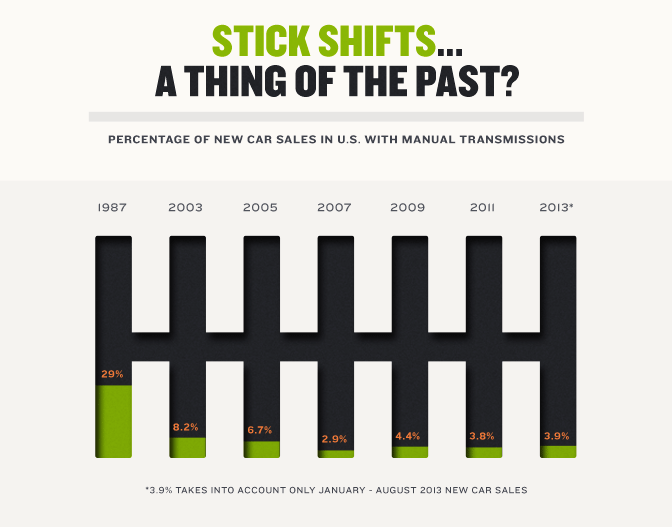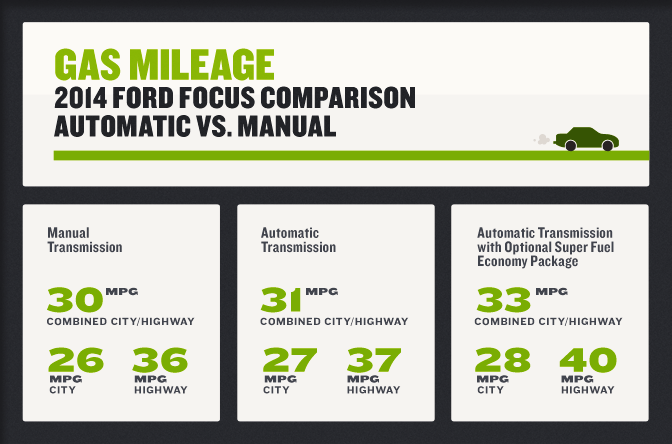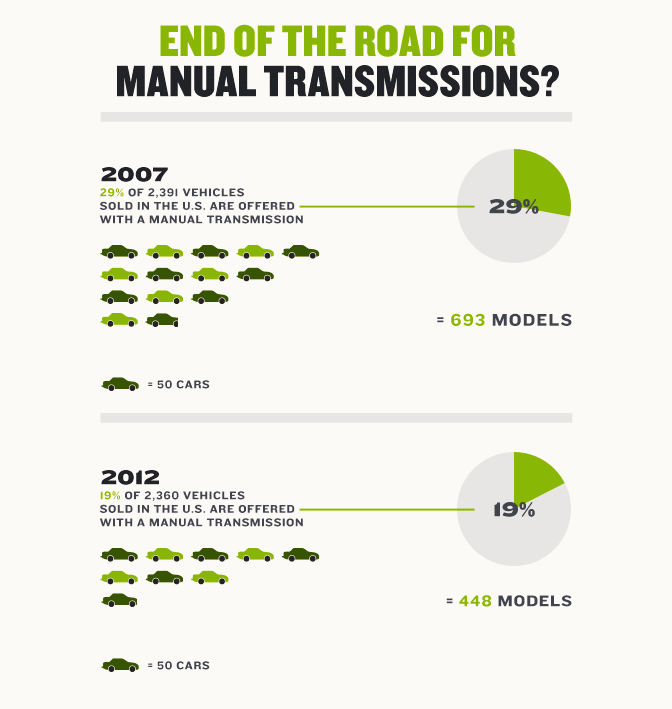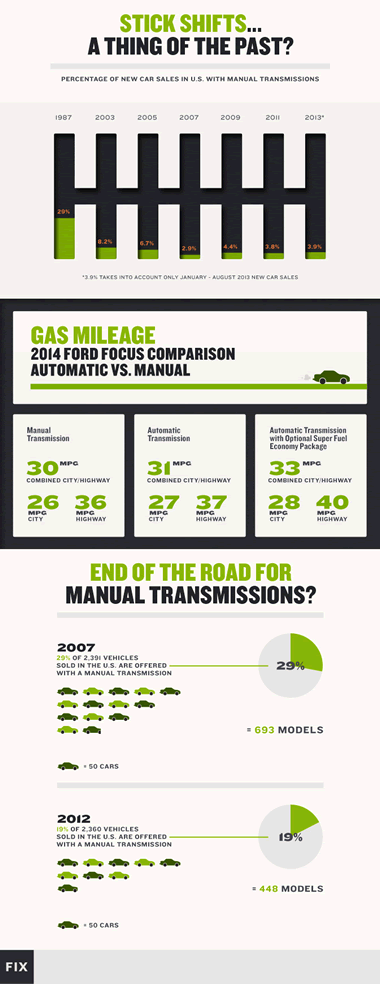Manual vs Automatic Transmissions
A Sticky Dilemma
From safety innovations to failed manufacturers, the automotive industry has dramatically changed in the past 30 years.
One of the biggest changes is the improvement in automatic transmissions. Manual transmissions were once dominant, particularly in sports cars. But that‘s no longer true.
According to Edmunds.com, the online automotive research company in Santa Monica, Calif., manual or stick shift transmissions comprised roughly seven percent of new car sales in the first quarter of 2012. http://content.usatoday.com/communities/driveon/post/2012/04/stick-shift-manual-transmission-ford-focus-surprise-more-interest-------/1#.U0wxGeZdXGA By August 2013, the new cars sold in the U.S. with manual transmissions had dropped to 3.9 percent. http://www.edmunds.com/fuel-economy/five-myths-about-stick-shifts.html
Twenty-seven years ago, 29 percent of new cars sold in the United States were equipped with manual transmissions. http://business.time.com/2012/08/02/last-gasp-for-the-stick-shift/

“Better gas mileage used to be a big consideration, too,” said Jessica Caldwell, a senior analyst at Edmunds.com. “But automatic transmissions are so much more efficient, that‘s often no longer a factor.”
A 2014 Ford Focus, equipped with a six-speed automatic transmission has EPA estimates of 27 mpg in city driving, 37 mpg in highway conditions and 31 mpg combined. If equipped with an optional Super Fuel Economy package, the fuel mileage improves to 28 mpg city, 40 mpg highway and 33 mpg combined. A 2014 Ford Focus with a manual transmission averages 26 mpg in the city, 36 mpg on highway scenarios and 30 mpg combined. http://www.fueleconomy.gov/feg/bymodel/2014_Ford_Focus.shtml

Why The Shift?
The improved efficiency of automatic transmission, first used in the 1920s, is further demonstrated by the increased popularity of two shifting options: Continuously variable transmissions (CVTs) and semi-automatic transmissions (paddle shifters).
CVT provides a seamless shift through an infinite number of effective gear ratios between maximum and minimum values. As a result, CVT can provide better fuel economy than other transmissions since the engine is able to perform at its most efficient revolutions per minute (RPMs).
Although the CVT option has been used in commercial trucks for decades, passenger vehicle manufacturers didn‘t begin to use it en masse until the early 2000s.
The 2014 Nissan Versa is available with three transmission options: five-speed manual, four-speed automatic, and CVT. The manual and automatic transmissions are rated with the same combined fuel economy, 30 mpg. The CVT option averages 35 mpg combined. 2
In higher-end cars, automatic transmissions have likewise vastly improved. A 2013 BMW 328i is rated at 26 mpg combined, whether it is equipped with a manual or automatic transmission. 2
Another reason for the transmission transition is simply convenience. Older drivers and younger drivers are likely to prefer automatic transmissions respectively because of the increased hectic nature of driving and sheer eagerness to obtain their licenses.
“It‘s one thing to enjoy shifting gears on an open canyon road,” said Caldwell. “That‘s part of the basics of enjoying the core tasks of driving. But who has the time for that anymore? And because traffic, particularly in city driving is so much more intense, automatic transmissions make more sense to a lot of people. I also don‘t think a lot of younger drivers want to take the time to learn manual transmissions.”
End of The Road
The major transition to automatic transmissions has some industry analysts suggesting the manual transmission will soon be obsolete. And, the statistics speak of a decline in the availability of the manual option.
According to USA Today, in 2007, 693 models of new vehicles sold in the U.S. were available with manual transmissions. By 2012, 448 new models sold in the U.S. were available with manual transmissions. 1 Which is a decrease of over one third in 5 years. Furthermore, in 2013, 67% of new car models were only available with automatic transmissions. 2

The Sporty Shift
Even among high-end sports car like Ferrari, there‘s been a shift in shifting. Once a bastion of traditional shifting, the Ferrari 458 no longer includes a manual shift box. Instead, the high-performance machine features steering wheel-mounted shift paddles that are connected to a semi-automatic gearbox. Porsche, Lamborghini, and McLaren all have automatic transmissions in supercars that were once equipped with manual transmissions.
The Chevrolet Corvette, often called “America‘s Sports Car,” has also made the switch. At least one 2015 model of the high-performance car will be will be equipped with a new rear-wheel-drive eight-speed automatic transmission. The 2014 Corvette Stingray features a standard seven-speed manual transmission or an optional six-speed automatic transmission.
According to the EPA, the 2014 Corvette with seven-speed manual transmission averages 17 mpg in city driving and 29 mpg on the highway. A 2014 Corvette with six-speed automatic transmission gets 16 mpg in the city, 28 mpg on the highway http://www.edmunds.com/chevrolet/corvette-stingray/2014/mpg.html
Consumer Reports in 2014 reported in a comparison of manual and automatic transmission that a stick shift can improve gas mileage from 2 to 5 mpg and can cost as much as $800 to $1,200 less than an automatic. It also noted that manual transmissions can improve acceleration. http://consumerreports.org/cro/2012/01/save-gas-and-money-with-a-manual-transmission/index.htm
But the publication also reported that resale value could be significantly lower on manual transmission vehicles since they‘re in far less demand. And like Edmunds.com Consumer Reports cited increased traffic and the requirement of advanced learning skills as significant reasons why automatics are increasingly more popular.
Yet, Not Everyone Agrees...
“Every year fewer cars are offered with a clutch and a shifter,” wrote Ben Stewart of Popular Mechanics. “For one thing, it‘s simply easier for drivers to let an automatic or an automated manual with paddle shifters do the work for them.”
“And in sports cars (the worst offenders), the newest computer-controlled transmissions shift more quickly than any human car, so engineers see the manual being as outdated as a caveman‘s club. But we disagree. A manual is more engaging and fun, requires more skill, and makes the driver better.”
In theory, drivers of manual transmissions spend more time shifting and therefore have little time to get distracted using the increased technology many newer cars come equipped with. Likewise, using smart phones or other personal devices is less likely for drivers of manual shift vehicles.
“Its true, driving a stick shift requires more concentration,” said Caldwell. “And that’s good because new technology increases the potential of driver distraction. But I don‘t think that will change consumers‘ trend toward automatic transmissions. I think the manual transmission ship has sailed.”
Embed the article on your site

